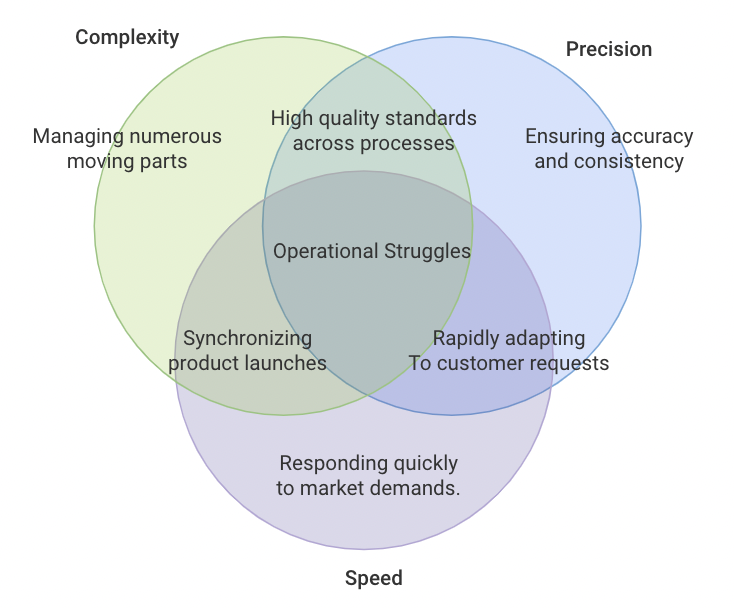
Transform Your Supply Chain Planning and Marketing Strategies with Google Cloud and SAP Integration

Transform Your Supply Chain Planning and Marketing Strategies with Google Cloud and SAP Integration
July 5, 2024 | Tarun Kumar
Blog / Handling Holiday Sales Surges with AI Agents: A 4th of July Postmortem
The 4th of July is an exciting time for shoppers, but it can be a challenging period for businesses. With the surge in holiday demand, companies often find themselves scrambling to keep up. Predicting customer behavior becomes a guessing game, inventory levels are hard to manage, and ensuring product quality under pressure is a constant struggle.
During this hectic time, traditional methods often fall short. You might find yourself overstocked with items that don’t sell or, worse, out of stock on bestsellers. The rush to meet demand can also lead to quality control issues, resulting in defective products reaching customers and hurting your brand reputation.
These challenges extend beyond the 4th of July to other major retail events such as Back-to-School season, Halloween, Black Friday, Cyber Monday, Christmas, and New Year’s sales, each requiring robust strategies for inventory management and quality control.
In many of these events, some of the most common scenarios companies face include:
You plan meticulously for the holiday rush, yet actual sales often surprise you. The gap between forecasted and real demand can lead to overstocking or understocking, each causing operational headaches and financial losses.
Nothing frustrates customers more than finding their desired items out of stock. Despite your best efforts, sudden surges in demand can leave shelves empty, driving customers to competitors and damaging your brand loyalty.
The rush to meet increased demand can strain your quality control processes, leading to defective products reaching customers. This results in returns, refunds, and a tarnished reputation, making it harder to retain customer trust.

Demand planning is an intricate process riddled with complexities. You’re not just dealing with a single data point but a multitude of variables that influence demand. These include historical sales data, market trends, promotional impacts, weather patterns, and economic conditions. Each of these variables can significantly affect consumer behavior.
The Challenge of Integration
The challenge lies in integrating these diverse data signals into a cohesive demand forecast. Sales data from your ERP system, market trends from Google Trends, promotional activities, and external factors all need to be considered. This is where AI becomes indispensable. AI can handle vast amounts of data and identify patterns and correlations that are impossible to detect manually.
While the need for AI is apparent, the reluctance is equally palpable. The success of AI rests on multiple parameters:
In the enterprise context, companies are exploring three options for deploying AI:
Decision Intelligence Platforms act as an intelligence layer on top of your ERP. This means if a planner uses SAP IBP, they can leverage these platforms for advanced analytics and integrate the insights back into their demand plans. Planning in a Box, Pluto7’s platform stands out for several reasons:
While Planning in a Box creates a strong data foundation, Pi Agent translates complex data into everyday conversations. This ability to create dashboards, generate demand plans, and identify aging SKUs with just a prompt becomes invaluable when time is limited, and accuracy is essential. Let’s explore a few scenarios to see how Pi Agent can simplify supply chain planning.
Forecasting demand for peak sales periods typically requires accessing data from multiple sources. Manually consolidating this data and generating insights can take up to 10 hours. With Pi Agent, planners can ask, “Hey Pi, what products will be in high demand?” Pi does an enterprise data search, analyzes the data in BigQuery, and returns insights in under 10 minutes.
Demand planning is one piece of the puzzle. The other is inventory optimization. Typically, a supply chain analyst spends 8 hours checking stock levels, projecting sales, and placing orders. With Pi Agent, they can ask, “Hey Pi, how should we adjust our inventory?” Pi monitors real-time inventory data and suggests reordering fast-selling items in less than 5 minutes.
In high-speed production, you can’t afford a 10-20% defect rate. This not only wastes resources but also risks delays or faulty products reaching customers, who may then switch to competitors. Typically, you would need up to 12 hours for manual inspections and quality checks to solve this. With Pi Agent, a quality control manager can ask, “Hey Pi, what’s the defect rate for the current batch?” Pi integrates with manufacturing data, identifies anomalies early, and provides actionable insights in real-time.
It’s a misconception to think such AI capabilities will take years to implement. With the right approach, you can see tangible outcomes in less than 4 weeks. Many supply chain leaders have told me, “My data is all over the place. I’m not ready for AI.” To them, we have shown that Planning in a Box addresses data silos, ensures data security, master data management, and governance. It ticks all the boxes in data preparation, and that’s why it is able to provide high-quality output.
While you review what went wrong in your next planning review meeting, consider this: AI can be your biggest competitive advantage, and we can help you achieve that. Reach out to us below for a workshop and see the transformation we can help you achieve in 48 hours.
ABOUT THE AUTHOR